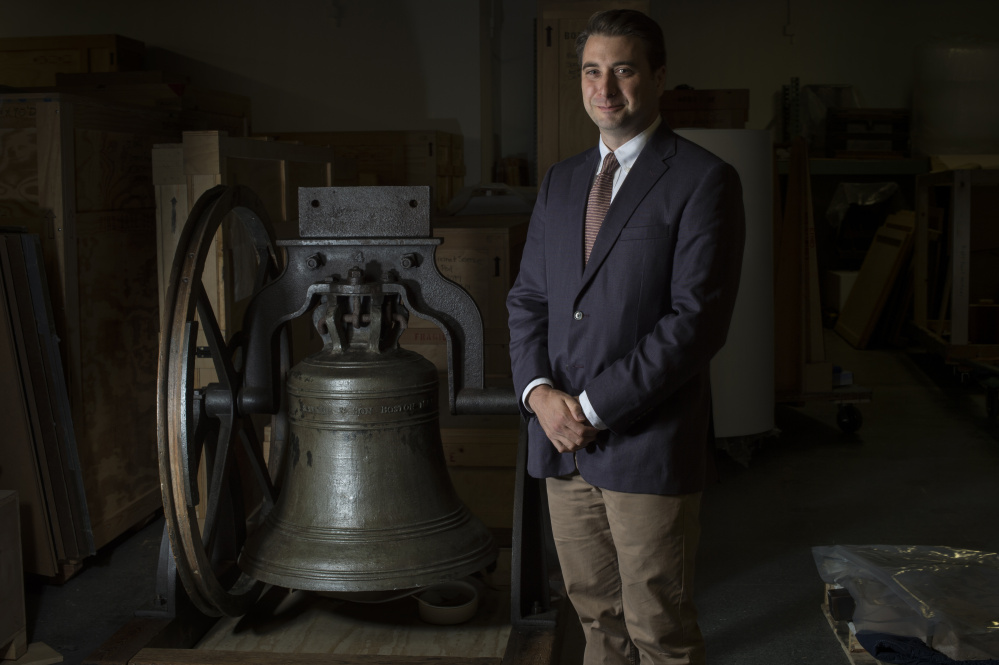Peter Manseau was born for this job. The son of a priest and a nun, Manseau was meant to be a scholar making sense of religion. Now his job, as the Smithsonian’s first curator of religion in more than a century, is to remind Americans of our nation’s religious history, in all its diversity, messiness, import and splendor.
“You can’t tell the story of America,” he said, “without the role of religion in it.”
The Smithsonian, the nation’s museum, hired Manseau to curate new exhibits on American religious history and to collect important religious objects to add to the museum’s expansive holdings. In this new position, underwritten by a $5 million grant from the nonprofit Lilly Endowment, he’ll lead a five-year series of events and exhibitions. The position was last held by someone in the 1890s, Manseau said.
Manseau eagerly describes the items he will place on display in his first exhibit, on religion in early America, which will open at the National Museum of American History in late June.
A church bell, crafted by Paul Revere. A Bible carefully excised, with a pair of scissors, by Thomas Jefferson, of all the parts about God that he could not believe. Manuscript pages from the Book of Mormon, on display for the first time outside a Mormon institution. The only Muslim instructional text known to have been written in America by an enslaved African man. A Torah scroll damaged during the Revolution, when Hessian soldiers employed by the British stormed a New York City synagogue.
“It’s the first time in generations that we look at religion in a holistic, comprehensive way,” Manseau said about the new exhibit, and he prides himself on the wide range of faiths he’ll be highlighting. “It’s taking a very broad view of religion in America, including and welcoming to all, without any obstacles.”
Then there are the items that require a more creative curatorial leap, objects not as obvious as religious texts and ritual implements that also tell the story of American religion.
A bottle of patent medicine, still half-full of “extract of liverwort,” sold by Shakers in the early 19th century to support their fledgling religious community. Sticks for playing a Native American sport, which originated as a religious ritual before it became the game we know as lacrosse. The compass that Roger Williams used to navigate his way to Rhode Island, the state he founded when he was exiled from Massachusetts for religious heresies.
These historic objects, Manseau hopes, will resonate with visitors who hear quite a lot nowadays about the religious freedom that America’s founders intended. He imagines that when some people see Williams’s compass, they will reflect on whether, say, America’s guarantee of religious freedom grants a baker the right to refuse to make a cake for a gay wedding.
He also expects that his work at the Smithsonian will involve memorializing the times when Americans turned with suspicion upon one religious group or another – Mormons, Catholics, Jews – in a way that parallels the way many politicians stoke anxiety about Muslims today. “Religion in America has always been complex and diverse, and it’s always been a relationship between different communities,” he said. “We can learn a lot about how we can make it through this moment by looking at moments in our history.”
To encourage that sort of interaction, he’ll put on a series of events at the Smithsonian, starting with a performance of the religious sounds the first Pilgrims may have made and heard – the hymns of those colonists sung alongside Wampanoag Native American sacred music – on Saturday and Sunday, then a show about religion in jazz in December.
Manseau has been studying and writing about America’s religious landscape throughout his career. His books include “One Nation Under Gods,” about the country’s long history of pluralism, and a memoir about his parents’ Catholic marriage.
He got his start at the Yiddish Book Center. Driving the center’s truck to elderly Jewish people’s homes to collect their books, Manseau had no personal stake in this Jewish history – and yet, he said, it felt like his own heritage. He loved the American writers who were inspired by Yiddish literature, so much so that he eventually wrote his own novel about a Yiddish poet. Even as a born Catholic who is now a sometimes-attendee at a Presbyterian church, Jewish history felt in part like his own.
That’s the feeling he aims to spark in others at the Smithsonian: “I would like visitors to feel that no matter what they believe or don’t believe, these stories of religion in the nation’s history are part of their history as Americans.”
Copy the Story LinkSend questions/comments to the editors.



Success. Please wait for the page to reload. If the page does not reload within 5 seconds, please refresh the page.
Enter your email and password to access comments.
Hi, to comment on stories you must . This profile is in addition to your subscription and website login.
Already have a commenting profile? .
Invalid username/password.
Please check your email to confirm and complete your registration.
Only subscribers are eligible to post comments. Please subscribe or login first for digital access. Here’s why.
Use the form below to reset your password. When you've submitted your account email, we will send an email with a reset code.